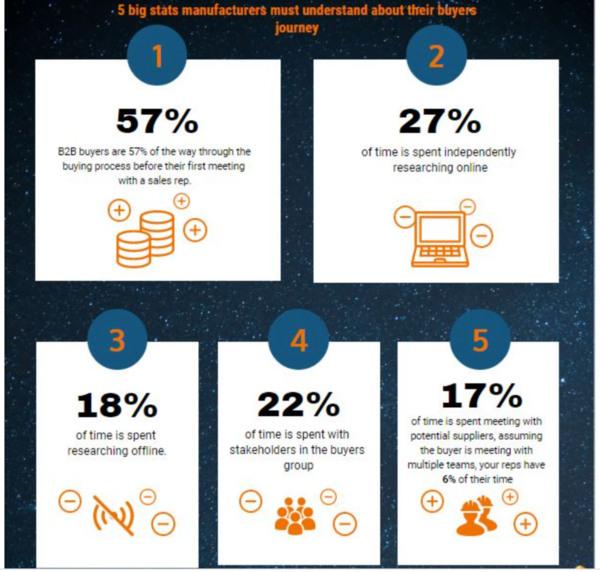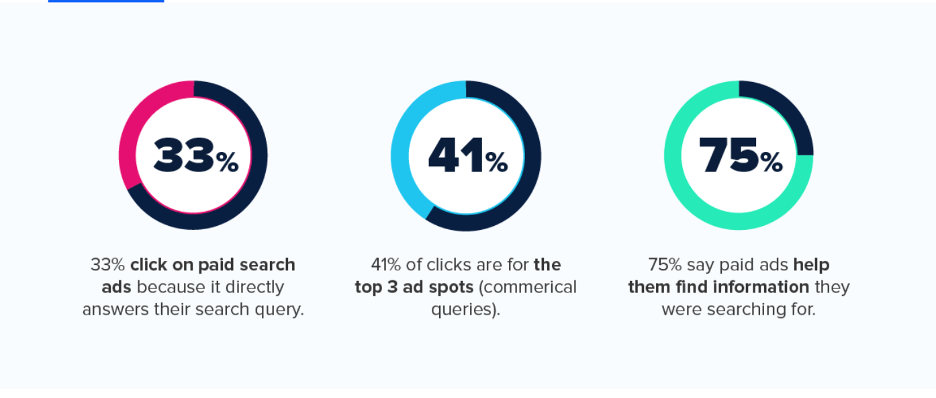Manufacturing Company Digital Marketing Strategy Essentials
Digital marketing for manufacturing companies can be a source of rapid growth in these uncertain times. In fact, a digital marketing strategy is one of the most important actions you can take in order to stay ahead of your competition.
An effective online strategy can bring you new leads and sales, improve your brand image and bring greater profitability to your business.
Manufacturing industries that ignore online marketing risk being left behind by their competition. Spending time to build your digital marketing strategy is worth it.
Better understand how important this marketing and sales investment is with this article.
A fundamental goal in B2B digital marketing is to drive quality traffic to the website and then from there generate leads. Why? Think of your website as a business asset. You’ve invested money in your website, and if you’re not thinking of it as an asset then you have a misunderstanding as to its role and importance to your business growth.
As with any business asset, one measures ROI. The tactics that are employed through online marketing, whether it be marketing campaigns such as SEO, Inbound marketing, PPC advertising, social media, or with marketing automation initiatives are tracked and measured in determining their effectiveness – and the ROI they are producing for your business.
In this article, we discuss essential building blocks for your digital marketing strategy.
Build a User-Centric Website
Since the website is at the base of the plan, the quality of your website is important. A good website is no longer one that is “brochure-beautiful”, but rather one that is designed to deliver ROI.
We talk about “user experience” and this puts the highlight on the user, your buyers, or target customers. We see many manufacturing companies making the mistake of sounding like a brochure in their website copy, describing the offering in language that gets them excited. However, buyers want to read how you solve their problems, not so much how great you think you are. Telling them how outstanding your products and services are – in other words – putting your strengths in your own terms, is no longer effective.
What customers and potential buyers really want to see is what you can do for them. Today we focus on customers, their needs, and problems to create engaging content that will take your company to the top of page 1 on Google.
Nowadays, many people browse websites on their phones. So a mobile responsive website is a must. This gives users a good user experience based on their device of choice, providing content that is easy to navigate and most importantly, to find the information they’re looking for.
And lastly, your website needs to be up-to-date. Inaccurate information will hurt your reputation and make you look old-fashioned and not relevant to today’s buyers and decision-makers. So, if you haven’t updated your site in the last 2 years, chances are the content needs to be refreshed.
 Image Source: Superoffice
Image Source: Superoffice
Understand Your Buyers
Today you need to understand who your buyers are, and what their varying needs are. For industrial buyers, there can be many people from different departments.
These can include:
- Business owners, Presidents, or CEOs
- Procurement managers
- Design engineers
- Research & Development (R&D) teams
- Distribution partner
Today’s buyers are doing their research online, and only making themselves known when they are close to making a decision on their selected vendor.
The big change in the overall buying process is that if your business is not being found in relevant searches, then you are not in the running for that business.
Here’s an example from one of our clients that perhaps you can relate to. This client sells complex, technologically advanced componentry within the defense industry. They woke up to the power of digital marketing when one of their biggest customers told them they were going to bring in another vendor.
The customer was happy with their work but wanted a second supplier. This meant our clients’ revenues from this customer would be reduced. How did the customer find the new supplier? Google. Where was our client in a Google search? Nowhere. The winner was on page 1.
They lost half their revenue from one of their most important customers to a company that used digital marketing to win a big piece of new business away from our client. When our client realized this is when we got a call from them and they became our client. We transformed their website into a search engine-optimized source of quality leads.
Now over a year later, they’re on page 1 of Google, and as this is written, ahead of that competitor. That competitor interestingly has paused their SEO work causing their rankings to fall, which was their mistake and our client’s gain. That’s life.
Building Buyer Personas for Your Business
In order to write compelling content that speaks to your buyer or target audience, a tool has been developed called “Buyer Personas”. These are developed by your team internally, or you will hire a digital marketing agency with expertise in persona development to craft them.
What is a buyer persona?
A buyer persona is a semi-fictional representation of your ideal customer and includes information such as demographics, psychographics, lifecycle stages, pain points, mindset, and other in-depth details to fully understand their buyer mindset.
Building buyer personas will help you understand your customers and prospects better. We talked about how businesses tend to promote their wares from their own perspective, rather than from the customer’s perspective. This problem is pervasive and results in weak, mediocre content.
Using buyer persona as the foundation of content marketing will enable your marketing team to write more effectively. We use buyer persona extensively in coaching our own writers and our client’s writers in producing more compelling content.
Having buyer personas is essential to personalization not only for web copy and blog articles. They will prove valuable as well when you create personalized email campaigns, landing pages, and even ads.
Using buyer personas in your marketing work ensures that the content you create targets each of the roles involved in the purchase process. The questions these people have to vary depending on whether they are the financial decision-maker such as a CEO, an operations director, the purchasing manager, a facilities manager, and so on depending on who is involved in the decision.

Use Content Marketing to Build Trust and Establish Authority
We use content published both on your website, and on other online portals to increase awareness of your brand, build trust in your brand, and establish your business as an authority in your industry. The content plan is developed to support the marketing goals you’ve set for your business.
A content marketing plan can consist of blog posts, video demonstrations, case studies, white papers and many more. The key is to provide helpful tips and resources to your audience, helping them understand how your offering solves a particular problem they have and want to resolve.
Ask your sales team what are the most common questions customers ask and then write articles that answer these. This gives both existing and new customers great reasons to come back to your site again and again. You are helping them. Over time, this builds trust and establishes your authority.
A consistent content marketing strategy also has the added benefit of getting ranked on Google. When your content is ranked high on search engines, it means that the content is being found by buyers who are using search phrases (keywords) that your content is associated with.
The more search phrases associated with the content, the more valuable the content will be deemed to be by. This translates into more traffic to the article, and to your website. From there leads will be generated for your business.
Increase Online Presence and Connect through Social Media Marketing
Social media is an excellent place to build your presence and connect with prospective buyers. When it comes to B2B marketing and manufacturing companies the social media strategy is not the same as you may see with a B2C or consumer brand.
Once the relevant social media platforms have been selected, and the content strategy and messaging established, social media is a highly effective place to establish, grow and maintain a brand presence.
Attract Target Audience with PPC Advertising

Some highly competitive industries use pay-per-click PPC advertising and consider it an essential source of leads and sales. PPC advertising is a great vehicle for getting news out quickly, generating buzz, testing an offer along with producing leads and sales.
Paid advertising is the fastest way to get your website ranking on the first page of Google. The ads are set up to appear for specific search terms. This ensures you are attracting your buyers with high search intent.
When there is an urgency in seeing results, PPC advertising is a great tool.
Here are some of the most popular paid digital advertising options:
- Pay-per-click ads (PPC) usually run on search engines such as Google and Bing. These ads allow you to insert a brief text description and link to an offer that buyers click on when the ads are in front of readers who are searching for your kind of content.
- Display ads are the flashy counterparts of text PPC ads and allow you to use a static or animated image to convey the message. It is a bit more costly but is generally more effective.
- Social media ads run on social networking websites such as Facebook, LinkedIn, and Twitter. Each platform provides a plethora of ad types and targeting options to fit any audience segment.
- Video ads could feature your product demos or explainers. These ads run on video streaming sites such as YouTube. Unlike traditional TV commercials, you get a lot more options to fine-tune your targeting.
Maintain Existing Relationships with Email Marketing
Email is the granddaddy of digital marketing, having had its 40th birthday a number of years ago. It is a well-respected tool to keep your company top of mind among customers and has become a backbone for B2B marketing communication.
Keep in touch with your existing clients by sending regular newsletters. You can introduce new products, upgrades, or anything new in the industry. This will foster these customer relationships, keep customers up to date on your product enhancements, create a culture of customer care, and show your ongoing support of ESG mandates and other things your customers care about. Email marketing shows your human side as a company.
Email is also an excellent way to nurture prospects. This is done through activities and special offers aimed at growing your subscriber list. The offer that is presented provides an “opt-in” opportunity that gets the buyer on your subscriber list. You then use creative content in a nurture sequence that keeps them engaged and keeps you top of your mind until they are ready to purchase.
Use Google Analytics to Know If It’s Working
Your digital marketing strategy for manufacturing companies isn’t complete without analytics. It’s the only way to know if your campaign is working.
There are tools like Google Analytics that make tracking easy. Digital marketing agencies are experts in analytics and pinpointing how to improve a campaign’s performance. A competent agency will craft campaigns designed to meet the marketing goals you’ve discussed together, and then monitor these campaigns, reporting back to you on performance and recommended next steps to build success for the long term.
Suggested Reads For You:



